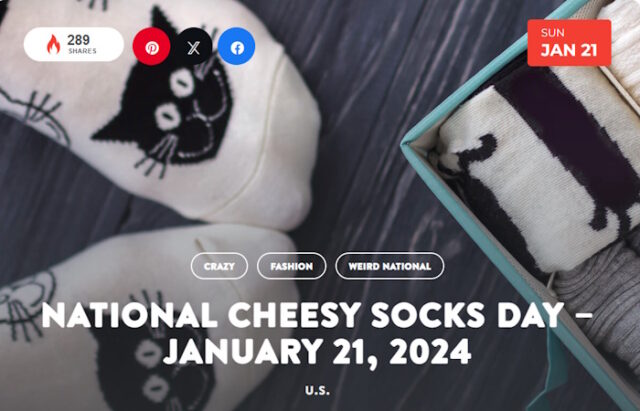
It wasn’t that long ago that socks were simply a utilitarian accessory that had no other purpose than keeping those feet warm. But in this modern day, socks have become a fashionable way for people to express themselves. And the more outrageous the better.
National Cheesy Socks Day offers the opportunity to call attention to the ridiculous and silly hosiery that is on those little tootsies!
- 2nd Century – Romans make fitted socks by sewing fabrics together.
- 8th Century – Socks are made from leather or matted animal hair. They were called piloi.
- 10th Century – Starting in the 10th Century, silk socks became a symbol of wealth and high rank in Feudal European societies.
- 15th Century – Argyle socks originated in Scotland in the 15th Century. Highland clanspeople used this pattern of intersecting diamonds as a complement to their clan tartan, the multi-colored plaid pattern featured on Scottish kilts containing a range of colors from greens to reds to blues.
- 17th Century – In the 17th century, socks were associated with political views. Noblemen wore white stockings, while peasants wore black ones. They believed that white represented freedom and equality, but it was a sign of aristocracy; on one hand, it meant they had enough wealth to wear something different than commoners, but at that time socks weren’t used by lower classes.
- 19th Century – The oldest known pair of socks is 1,600 years old and was excavated at the end of the 19th century from the burial grounds of ancient Oxyrhynchus, a Greek colony on the Nile in central Egypt. The socks are made from red wool and have split toes for wearing with sandals.
- 1938 – Nylon is invented and it’s used to make socks that are elastic and comfortable.
- 1980s – Ankle socks become a trend.
- 2001 – In 2001, a pair of socks sold for $1.98 million on eBay. The winning bidder, a Las Vegas casino owner, won with one of his own feet (the rules stated he had to wear it). After winning, he said that he wasn’t going to display it in a museum or anything – but rather keep it in his sock drawer
- 2000s – companies started manufacturing socks in bright colors and clever designs in sizes that would fit adults
- 2008 – Happy Socks, the Swedish sock company, was founded by a graphic designer in 2008 and their business boomed almost immediately.
- 2011 – researchers established that the average four-person family will lose 60 socks a year. What they can’t tell us though is where on earth they go?!
- The term ‘sock’ actually originates from the Greek word ‘sykhos.’ When the Romans started to take inspiration from the Greeks, socks started to be called ‘soccus.’
- Wearing socks increases the blood flow to your hands and feet, reducing your core body temperature quickly and helping you fall asleep.
- The Datang district in China is the top producer of socks globally, manufacturing about 40% of the world’s socks in one year! It has been named Sock City producing Millions of pairs of socks in one year, enough to supply two pairs to every person on earth.
- 82% of young men wear odd socks at least once a week.
- People who wear mismatched socks are more likely to be married. It’s more common for married people to dress in the dark, in an attempt to avoid waking their spouses. This results in them accidentally wearing socks of subtly different colors.
- A design on the ankle or side of a sock is called a clock
- According to traditional etiquette guides, the sock color should match the color of the shoes and/or trousers but should be at least one shade darker than the trousers and one shade lighter than the shoes.
- There are more than 100 types of socks.
- Men’s sizes are determined by shoe size, while women’s are based on leg length.
Sources:
Philosophy
Disclaimer
The information contained in South Florida Reporter is for general information purposes only.
The South Florida Reporter assumes no responsibility for errors or omissions in the contents of the Service.
In no event shall the South Florida Reporter be liable for any special, direct, indirect, consequential, or incidental damages or any damages whatsoever, whether in an action of contract, negligence or other tort, arising out of or in connection with the use of the Service or the contents of the Service. The Company reserves the right to make additions, deletions, or modifications to the contents of the Service at any time without prior notice.
The Company does not warrant that the Service is free of viruses or other harmful components












